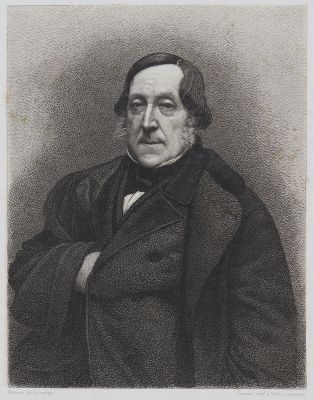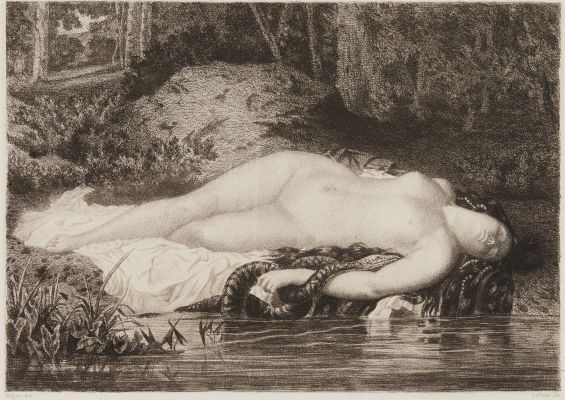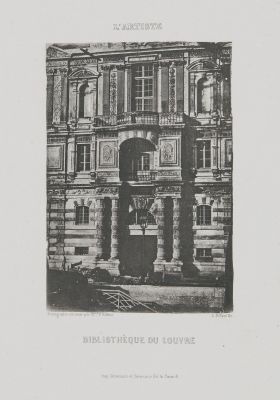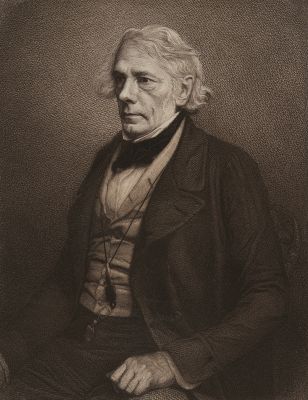
Title
Empress EugénieArtist
Winterhalter, Franz Xaver (German, 1805-1873)Publication
L'ArtisteDate
1854 plate (1859 negative)Process
Photogravure (heliograph)Atelier
Niepce de Saint-VictorImage Size
18 x 14.2 cmSheet Size
31 x 23.2 cm
Beginning in 1853, Niépce de Saint-Victor and the engraver Francois-Augustin Lemaître worked to improve aspects of Joseph Nicéphore Niépce’s heliographic technique. The collaborative effort successfully yielded an improved technique that, for the first time, allowed photographs to be translated into a printing plate. Their two principal refinements were making the bitumen of Judea more sensitive and adding an aquatint texture to hold the ink in large areas of tone. The process, however, produced images which were mostly unable to render delicacy of detail without the aid of extensive hand work. While it was clearly a photomechanical breakthrough, Niépce de Saint-Victor’s method did not last for very long, in particular because the process always required the intervention of an engraver. Its merit was that it was a pioneering method and opened the way to newer methods.
Examples of Niépce St. Victor’s Heliographs are rare. This one is from a painting by Franz Xaver Winterhalter. The original background has been replaced in the heliograph.
The daughter of a Spanish noble who fought on the French side during Napoleon I’s Peninsular War in Spain, Eugénie went to Paris when Louis-Napoléon became president of the Second Republic in December 1848. They were married in January 1853 after he had become the emperor Napoleon III.
The paining, Empress Eugénie of 1854 (no. 495), is currently held in the Museum of Fine Arts in Houston, Texas. It is believed to have been commissioned personally by the Empress and paid from her own funds: this fact that was recognized by the French Government in 1881 when it returned the portrait to the Empress in exile together with other paintings and works of art as her private property. The portrait was placed at Eugénie’s home at Farnborough Hill and remained there at least until 1884, when it was gifted to Mme Eugène Rouher (née Marie Cornélie Léontine Conchon (1822-1890)), widow of a prominent Second Empire politician and statesman, and remained in her possession in Paris until her death in 1890. The painting then passed through a number of private collections, and was acquired by the Museum of Fine Arts, Houston, with funds provided by the Agnes Cullen Arnold Endowment Fund, in 2010. [1]
References
[1] https://franzxaverwinterhalter.wordpress.com/2012/02/05/franz-xaver-winterhalter-empress-eugenie-of-1854-no-495/
Jammes, André, De Nieìpce A Stieglitz: La Photographie En Taille-Douce : [exposition], 19 Novembre 1982-20 Feìvrier 1983, Museìe De L’elyseìe, Lausanne. Lausanne: Le Museìe, 1982 no. 28
De Andere Fotografie de Geschiedenis van de Fotomechanische Reproductie in de Negentiende Eeuw: tentoonstelling in het Zeeuws Museum Middelburg 1989 (The Other Photography the History of Photomechanical Reproduction in the Nineteenth Century: Exhibition in the Zeeuws Museum Middelburg 1989) Exhibited chk. 21
McCauley, Elizabeth Anne, AAE Disdéri and the business card portrait photograph, New Haven: Yale University Press, 1985.











